Adaptive reuse projects have made industrial interior design a staple in our homes and businesses. It’s more than a fleeting trend; it’s a style that keeps evolving. This design brings a special charm to spaces that were once cold and tight.
Now, we see industrial design in everything from kitchens and living rooms to cozy bedrooms. It’s a popular choice for its mix of old-world charm and modern versatility. This blend makes industrial design a favorite among homeowners and businesses.
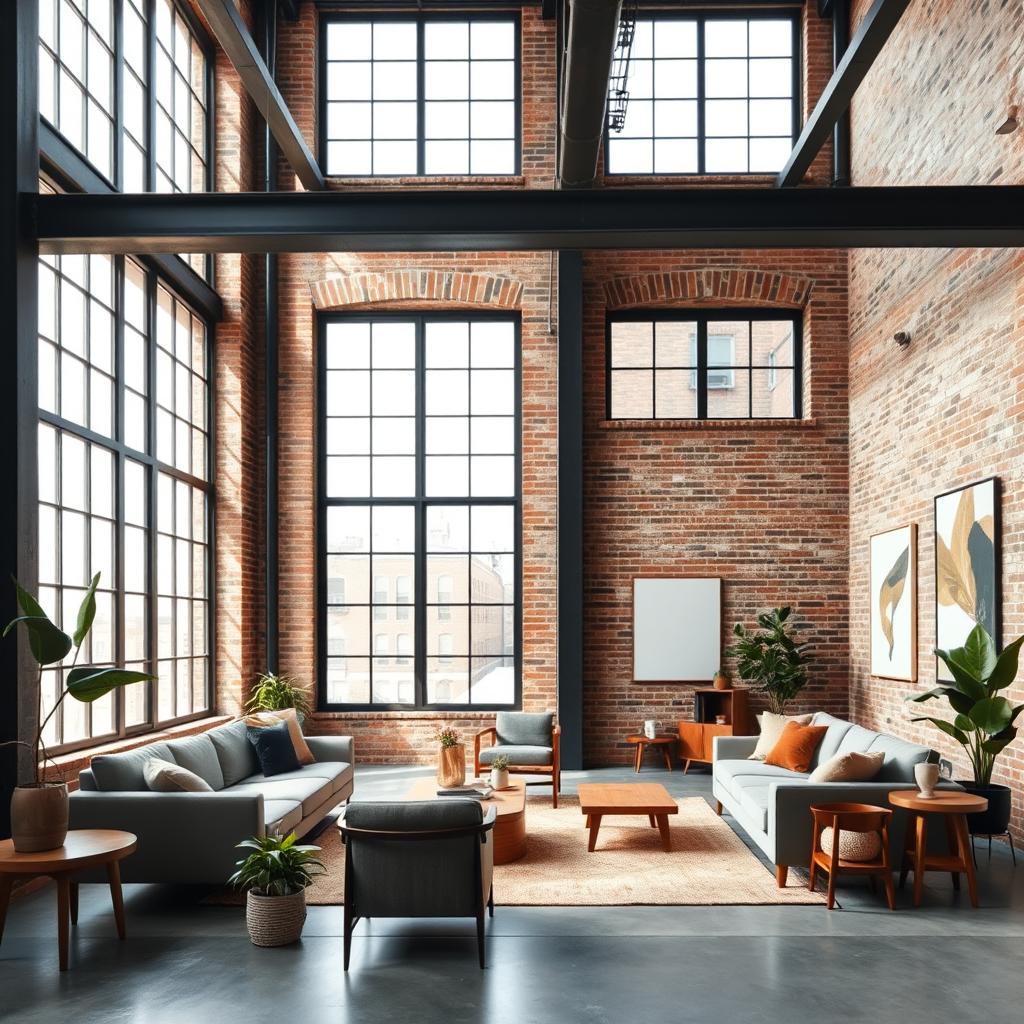
What is Modern Industrial Interior Design?
The modern industrial style interior has changed a lot from its early days. Back then, it was all about the look of factories and warehouses. Now, it mixes old industrial looks with new, modern touches. This creates a stylish and eye-catching space.
Evolution of Industrial Design Style
In the 1960s and 70s, old factories became homes. This trend made industrial design popular in homes and offices. Today, it’s all about combining the raw look of the past with clean, modern pieces.
Defining Elements of Industrial Interiors
- Exposed structural elements: Visible beams, pipes, and ducts create an unfinished, industrial ambiance.
- Neutral color palette: Shades of black, gray, and brown form the foundation of industrial-style interiors.
- Raw materials: Rough textures like exposed brick, weathered wood, and unrefined stone surfaces add visual interest.
- Open floor plans: Spacious, open layouts with high ceilings are hallmarks of industrial-inspired design.
- Mix of old and new: Blending vintage and modern elements, such as sleek furniture and rustic accents, creates a unique and inviting atmosphere.
The modern industrial theme interior design style is a perfect mix of old and new. It makes any space look great and work well.
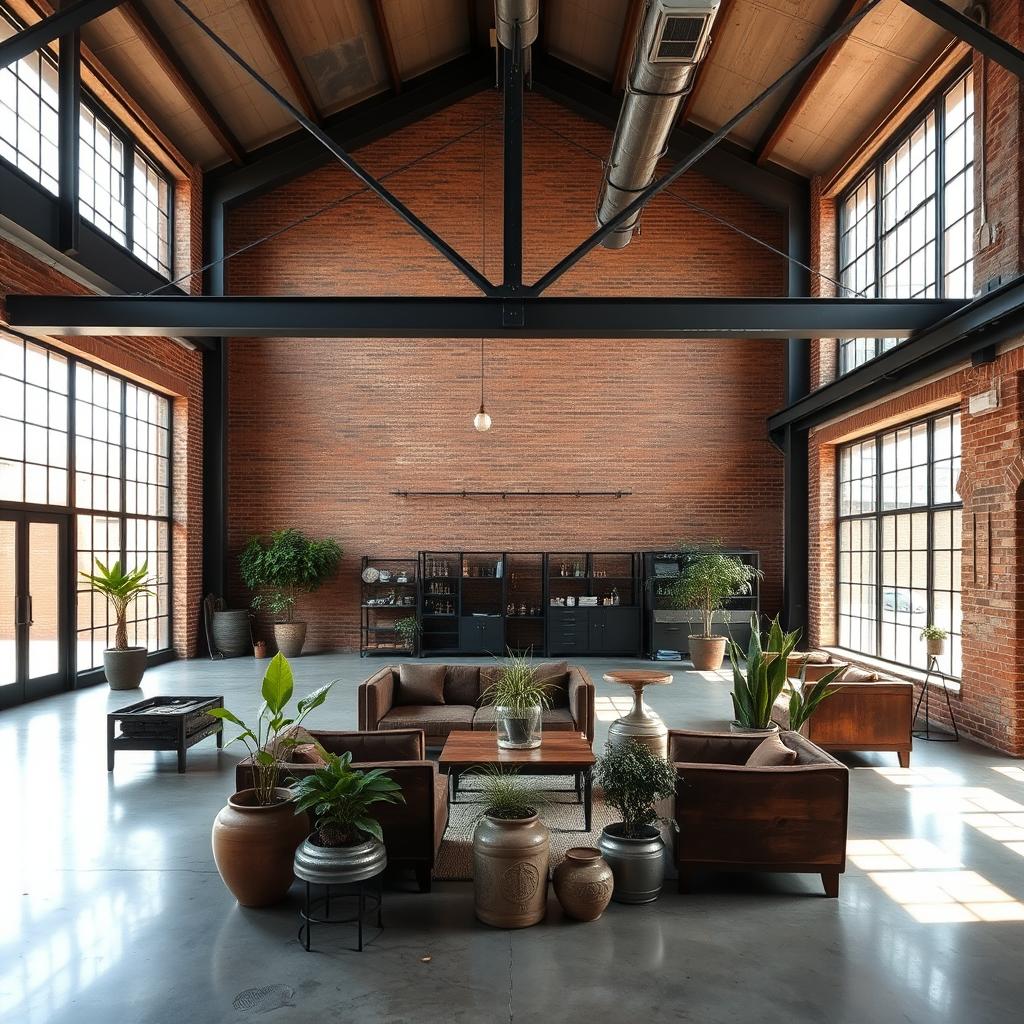
Examples of Industrial Interior Design
The industrial interior design style is very popular now. It’s known for its raw, authentic, and functional look. This style can be seen in kitchens, living rooms, and bedrooms, showing its versatility and appeal.
Industrial Kitchen Design
Industrial kitchens are bold and striking. They use black countertops, rustic wood, and concrete flooring. Exposed brick walls, metal accents, and industrial lighting add to the look.
This design is both functional and visually appealing. It makes the kitchen a standout space.
Industrial Living Room Design
Industrial living rooms aim for a cozy yet edgy feel. They often have concrete floors, wood ceilings, and steel doors or windows. This creates a raw and textured look.
Leather sofas and vintage chairs add to the industrial vibe. Indoor plants and soft textiles balance the space, making it cozy.
Industrial Bedroom Design
Industrial bedrooms use raw materials and exposed structures. They often have exposed brick, metal frames, and repurposed furniture. The colors are mostly neutral, with industrial colors like deep greens or blues adding interest.
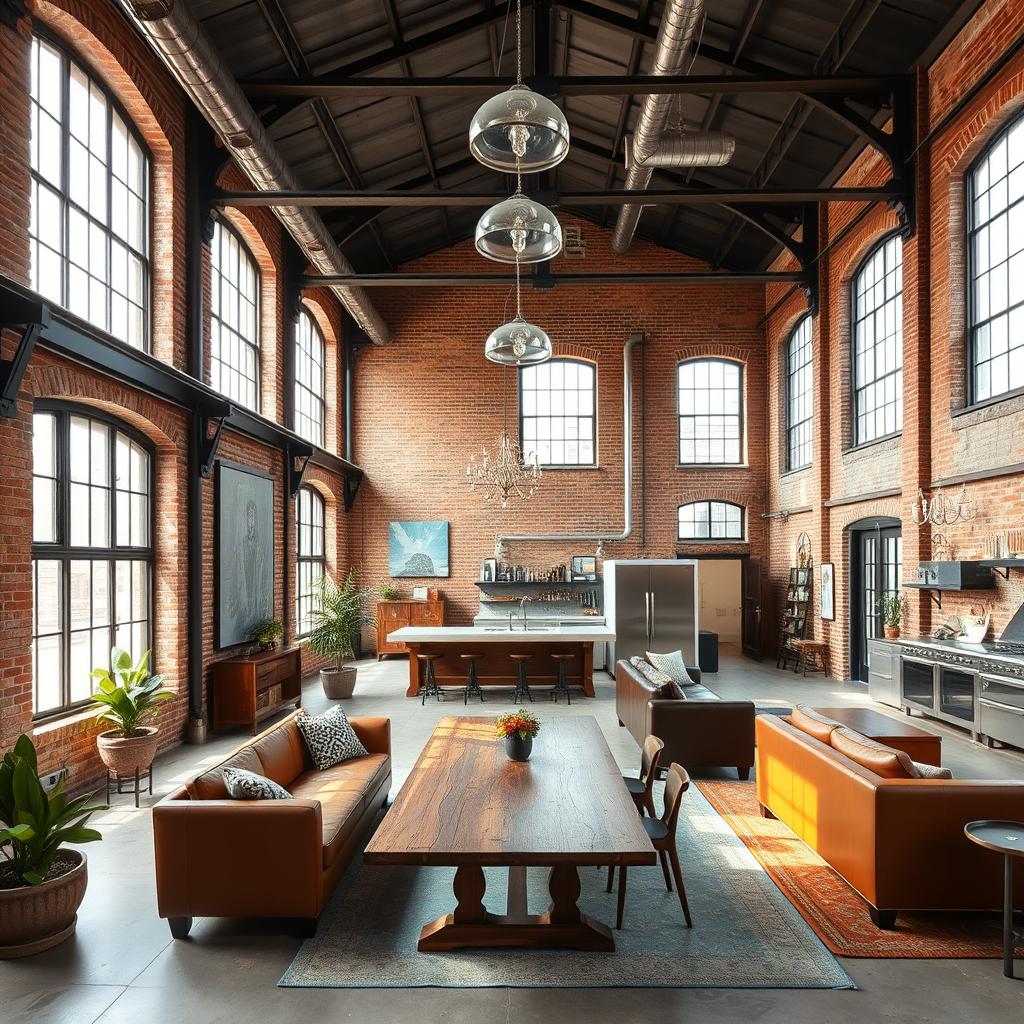
These examples show how versatile and appealing industrial design is. It can be used in many spaces, blending raw and refined elements. This style continues to inspire both homeowners and designers.
Incorporating Industrial Design in Hospitality Spaces
The industrial design trend has entered the hospitality world. It’s changing restaurants and hotels with its raw, unfinished look. Guests see sleek black metal, exposed ducts, and classic industrial features. This creates a unique and stylish vibe.
Industrial-style furniture is popular in hospitality. It’s durable and looks great. Pieces made from metal, wood, and leather mix beauty with function. This makes dining or lounging comfortable and practical.
Hotels are also using industrial furniture. They mix leather sofas, metal lights, and wooden tables with metal accents. This gives a sense of luxury and style. Industrial furniture is perfect for hotels because it’s easy to keep clean and lasts long.
Adding industrial design to hospitality spaces attracts modern guests. It’s practical and looks good. Industrial furniture and decor create a stylish atmosphere that improves the guest experience.
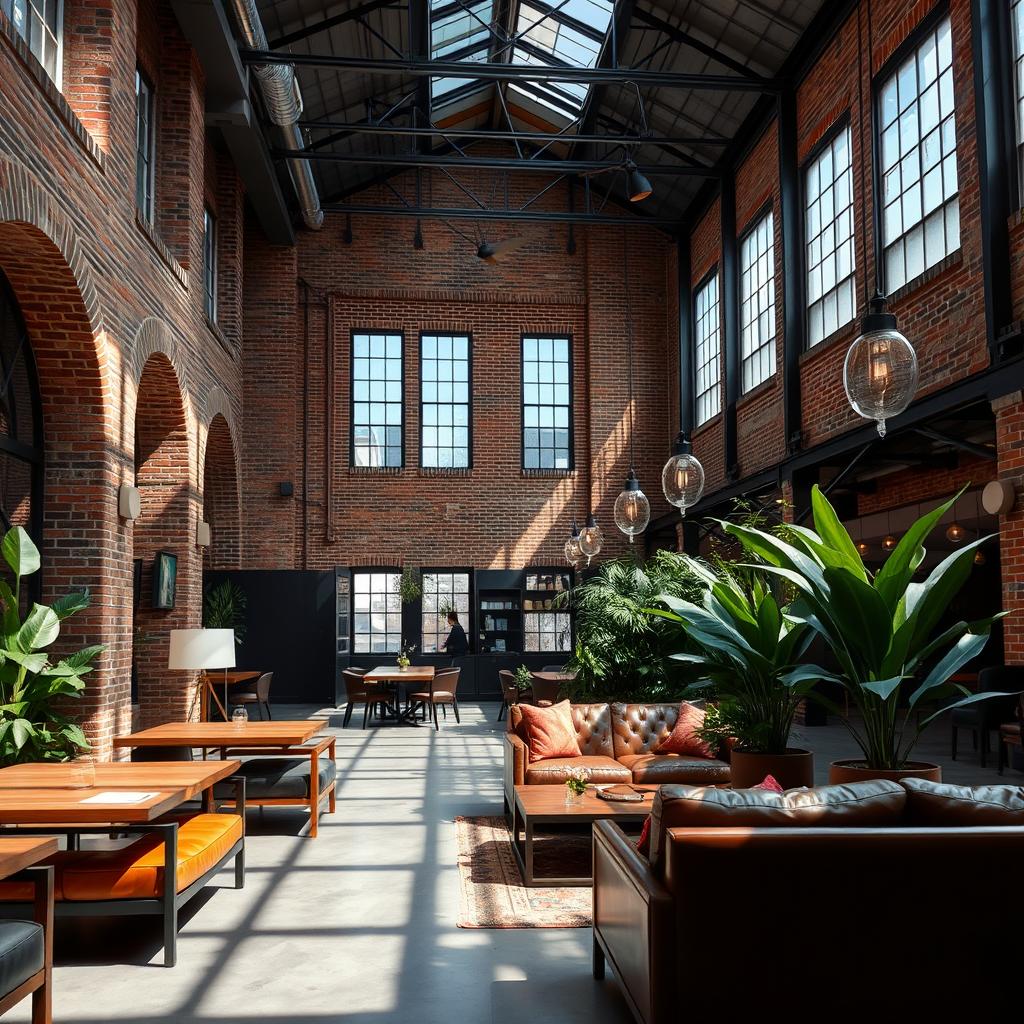
The industrial design trend is big in hospitality. It offers a unique and useful way to make memorable guest experiences. By using industrial design’s raw yet sophisticated elements, spaces can impress visitors. They provide a comfortable, functional, and striking environment.
Achieving an Industrial Look at Home
Bringing an industrial design into your home can refresh any space. The secret is in the lighting, color, and materials you choose. With these elements, you can turn any room into a modern industrial haven.
Lighting Considerations
Lighting is key for an industrial look. Choose fixtures with exposed bulbs, metal, and simple designs. Pendant lights and wall sconces are great for brightening up the space and adding to the industrial vibe. Placing them right can show off the room’s features and make it feel cozy.
Color Palette and Material Choices
The industrial style loves a simple color scheme. Stick to neutrals like beige, gray, and white. These colors let the materials shine. Add exposed brick, weathered wood, and metal for a tough yet elegant feel. Mix these with soft materials like bouclé or leather for a nice contrast.
| Key Industrial Design Elements | Examples |
|---|---|
| Lighting | Pendant lights, wall sconces, exposed bulbs |
| Color Palette | Beige, charcoal gray, white |
| Materials | Exposed brick, weathered wood, metal accents, leather, bouclé |
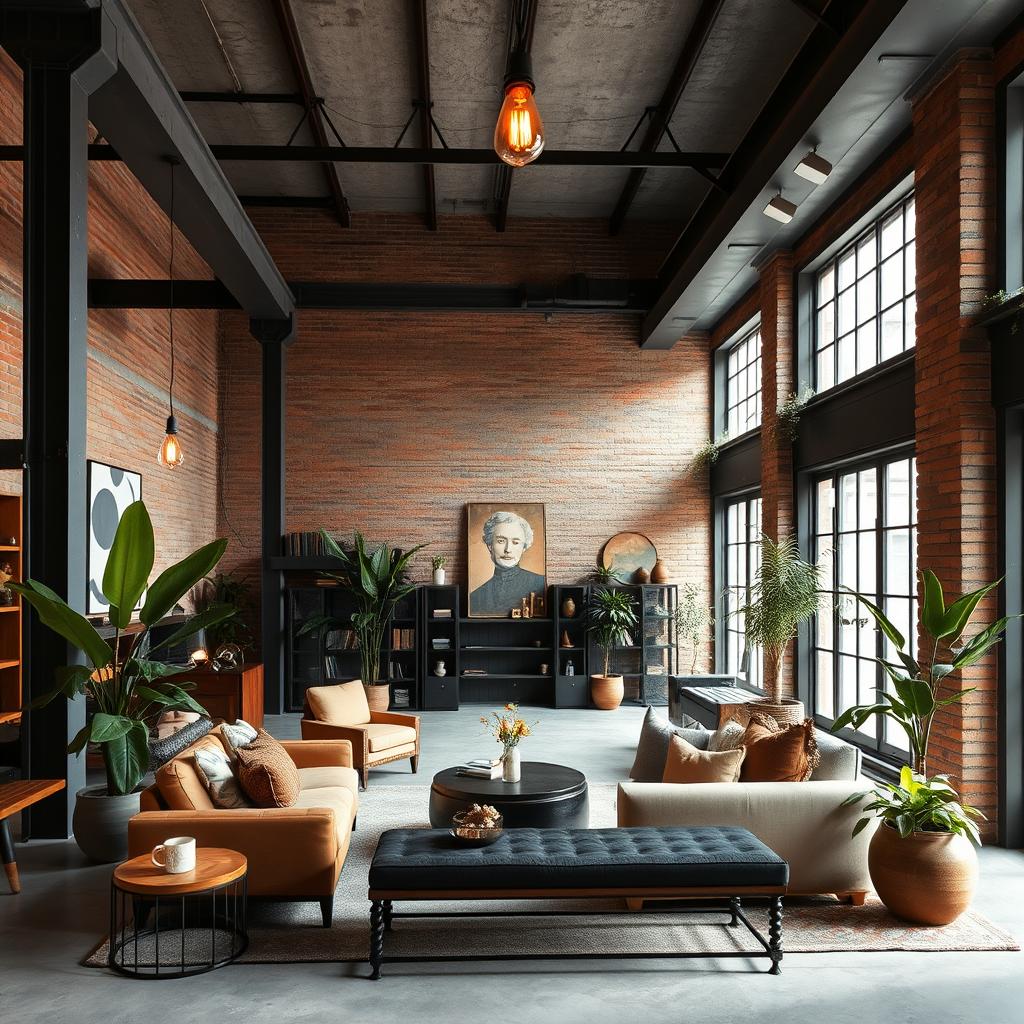
With the right lighting, colors, and materials, you can easily get the industrial look at home. This style celebrates the beauty of raw, industrial spaces. It lets homeowners create modern, functional spaces that are full of character and personality.
Embracing Minimalism in Industrial Interiors
The mix of industrial and minimalist design is very popular. Both styles love simplicity and clean looks. Minimalism in industrial interiors means having a few, well-chosen items. This lets standout pieces and the building’s structure be the main focus.
When you mix minimalism and industrial design, choosing materials is key. Industrial spaces often use wood and metal, while minimalism is about simplicity. Finding a balance between these styles can make a space both beautiful and functional.
Exposed brick and concrete are great for minimalist industrial design interior. They match well with metal and wood furniture and decor. Industrial-style storage, like grey metal cupboards, also adds to the minimalist look.
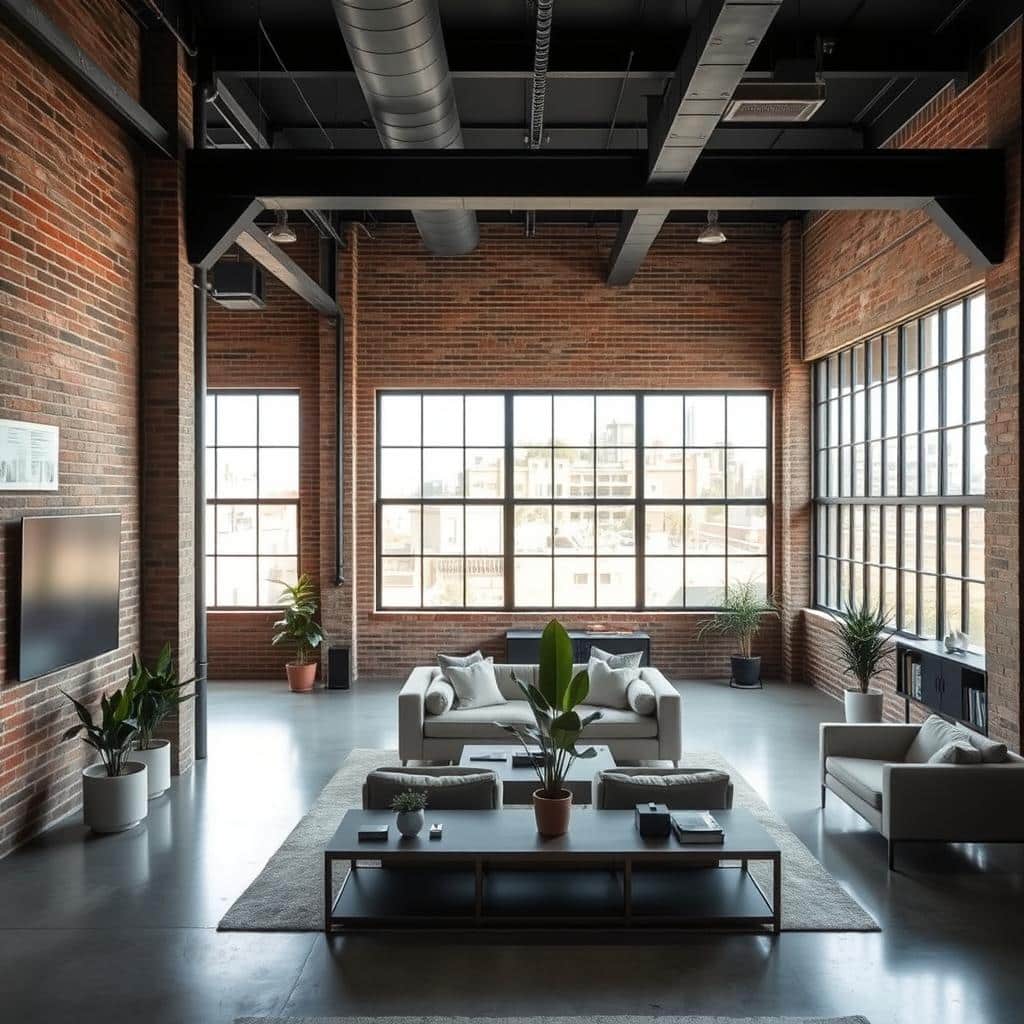
Lighting is very important in industrial minimalist design. Metal pendant lights and Edison bulbs add an industrial touch. They help keep the space clean and simple.
By picking the right materials, colors, and lighting, you can merge industrial and minimalist styles. This creates a space that is both beautiful and practical. It shows off your personal taste.
Prioritizing Practicality in Industrial Design
In industrial style interior design, practicality is key. This is very true in kitchens, where good lighting is essential. Homeowners and designers are choosing industrial lighting that looks good and works well.
Practical Industrial Kitchen Lighting
Fixtures like cone and glass funnel wall lights from Industville are perfect. They have an industrial look but also provide great lighting for kitchen tasks. These designs have exposed bulbs, metal finishes, and can be adjusted to light up specific areas.
These lights are not just stylish; they also light up the kitchen well. They shine light on countertops, sinks, and other important areas. This makes the kitchen more efficient and safer.
For those wanting a practical industrial design in their kitchen, these industrial kitchen lighting fixtures are great. They mix style with function, making the kitchen better for everyone.
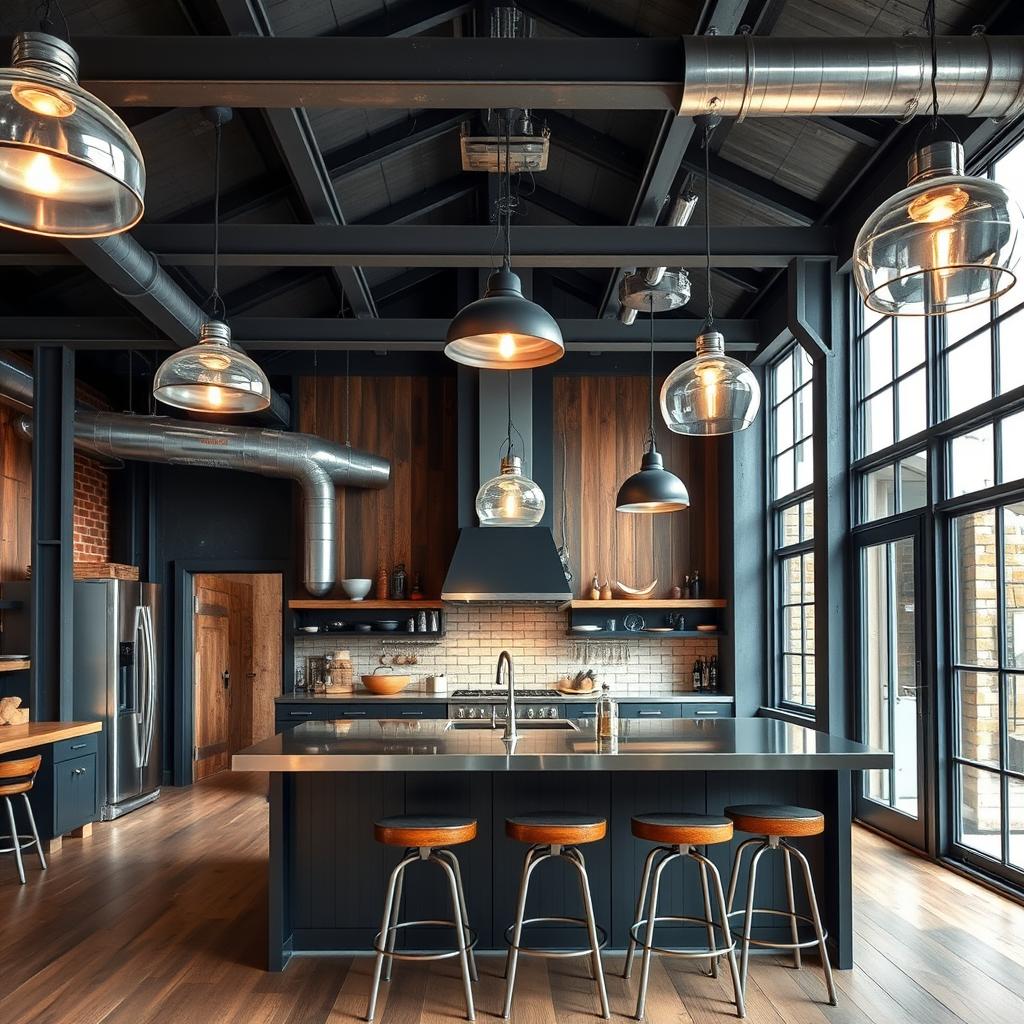
Industrial Interior Design: Embracing Individuality
Industrial interiors often have clean lines and simple looks. But, they also welcome unique touches and quirky details. Adding special art, custom lights, and reused industrial parts can make a space stand out.
Quirky Industrial Lighting Fixtures
Lighting is key in industrial spaces, letting you show off your style. Choose lights that are different, with unusual shapes or materials. Industville has customizable lights that can make your space truly unique.
- Old factory lamps or salvaged parts can add a handmade touch.
- Geometric metal pendant lights can make a strong statement.
- Big, sculptural lights with exposed bulbs or industrial materials can be room highlights.
Using unique lighting can make your industrial space feel more personal. It shows off your personality and makes your space special.
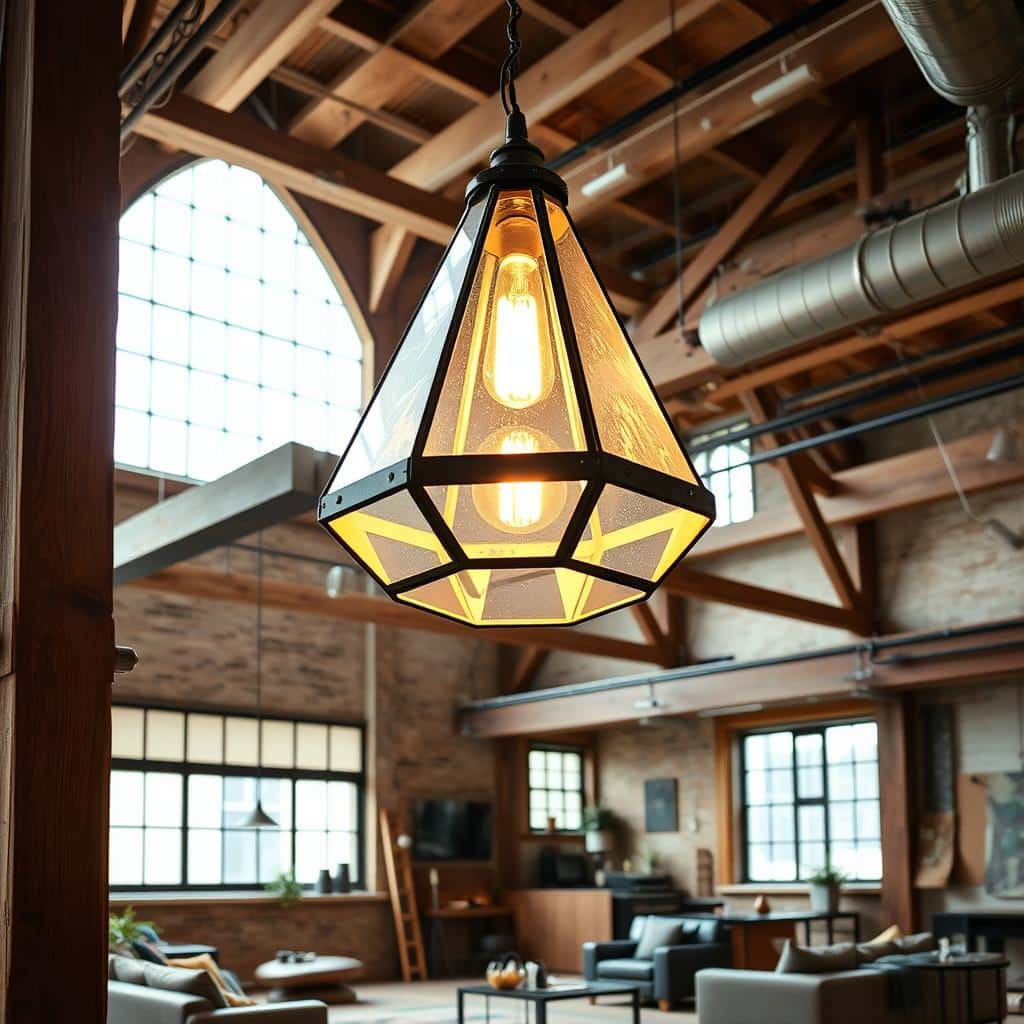
Favoring Metal Features in Industrial Interiors
Industrial interior design loves raw, utilitarian materials. Metal features are key to this look. Exposed pipes, structural beams, and sleek furniture all add to the industrial vibe.
Incorporating Metal Furniture and Accents
Metal furniture fits perfectly in industrial spaces. Its clean lines and rugged charm are a must. Pieces in warm copper, subtle pewter, or bright brass tones add to the look.
Adding dark-toned leather and weathered wood accents makes the space even more appealing. This mix creates a perfect blend of industrial chic.
| Metal Finish | Aesthetic Impact |
|---|---|
| Copper | Warm, rustic appeal |
| Pewter | Understated, sophisticated charm |
| Brass | Vibrant, statement-making presence |
Designers use metal furniture and accents to create stunning interior industrial spaces. A sleek metal pendant light or a reclaimed metal dining table can make a big difference. These metal features are essential for the industrial look.

Experimenting with Color in Industrial Spaces
Industrial interiors are not just cold and gray. There’s a wide range of metallic shades and textures to play with. Designers can mix different metal tones to create lively industrial spaces. These spaces balance the raw, rugged elements with a bright color industrial interiors palette.
Industville is a well-known brand in the industry. They offer industrial lights in various finishes. You can choose copper for a classic look, pewter for a subtle vibe, or brass for a softer feel. These options let homeowners and designers explore industrial color schemes and find the perfect shade for their vision.
Finding the Right Shade for Your Industrial Interior
When playing with color in industrial spaces, think about the lighting. Earthy tones like warm neutrals and rich greens make spaces cozy and inviting. Soft pastels, like blush pinks and mint greens, add a delicate touch.
Bold colors, like deep blues and vibrant yellows, can make a statement. They add personality and depth. Neutral-toned furniture helps balance the color scheme, letting the accents shine.
Getting advice from interior designers is helpful. They can pick the right colors for your industrial space. With the right lighting, materials, and scale, you can turn industrial interiors into lively, inviting places. These spaces show off the perfect mix of industrial charm and personal style.
Vintage Inspiration for Industrial Interiors
Vintage-inspired industrial lighting combines the charm of the past with today’s sleek looks. It lets homeowners create spaces that feel both timeless and real. This mix of old and new is perfect for those who love unique, authentic designs.
Choosing Vintage Industrial Lighting
When picking vintage industrial lighting, keep these tips in mind:
- Choose metal finishes like black, gold, copper, or bronze for an industrial look.
- Find lights with exposed bulbs or filament-style bulbs for a vintage feel.
- Go for geometric shapes and clean lines to match industrial design.
- Add industrial pipe elements or raw materials to enhance the industrial feel.
By choosing the right vintage industrial lighting, you can merge the past and present. This creates a space that’s both eye-catching and deeply personal.

Industrial Interior Design: Cement and Veining
Using cement-like finishes and veining patterns adds a lot to industrial design. For example, Dekton Kreta floors and Silestone Charcoal Soapstone countertops make a space look modern yet timeless.
There are many options for industrial cement design. Travertine stone like Savanah Bookmatch Travertine has a unique texture. Kilkenny Standard Limestone, has a subtle vein pattern. Kilkenny Commercial Limestone, is great for commercial spaces.
For a bold veining look, Grey Sparkle Quartz and Steel Grey Granite are good choices. They add black and light grey flecks to the design. Ciotolli Beige Terrazzo, adds depth and character.

Cement-effect paints like METEORE 10 CEMENTO by Valpaint also work well. They come in various finishes, from compact to vintage, large, slim, and smooth. This lets designers choose the right texture and pattern.
Materials like Design Concrete Collection by RAK Ceramics and Habana Dark Collection by Antic Colonial enhance the industrial look. Chemsurf Laminate by Wilsonart, Dekton Industrial Collection by Cosentino, and IRON Collection by Neolith are also good choices. They offer durability and versatility for industrial-style interiors.
Designers can make amazing industrial spaces by picking the right materials and finishes. This way, they can mix modern and timeless elements, highlighting the beauty of industrial veining and cement-like designs.
Unifying Spaces with Floor and Wall Cladding
Using the same material for both floors and walls can change the game in creating a unified look. Dekton Kreta is a great example of this. It makes the space look seamless and striking.
This method makes industrial elements work together beautifully. It creates a sense of design that’s intentional and polished. The result is a refined industrial interior that looks great.
This design choice has more than just visual benefits. It also makes the space more durable and easier to maintain. It gives a sophisticated look, perfect for busy areas or commercial spaces.
Designers can create unified industrial spaces that impress and blend raw and refined elements. This method is a key tool for making industrial interior design that’s both cohesive and striking.
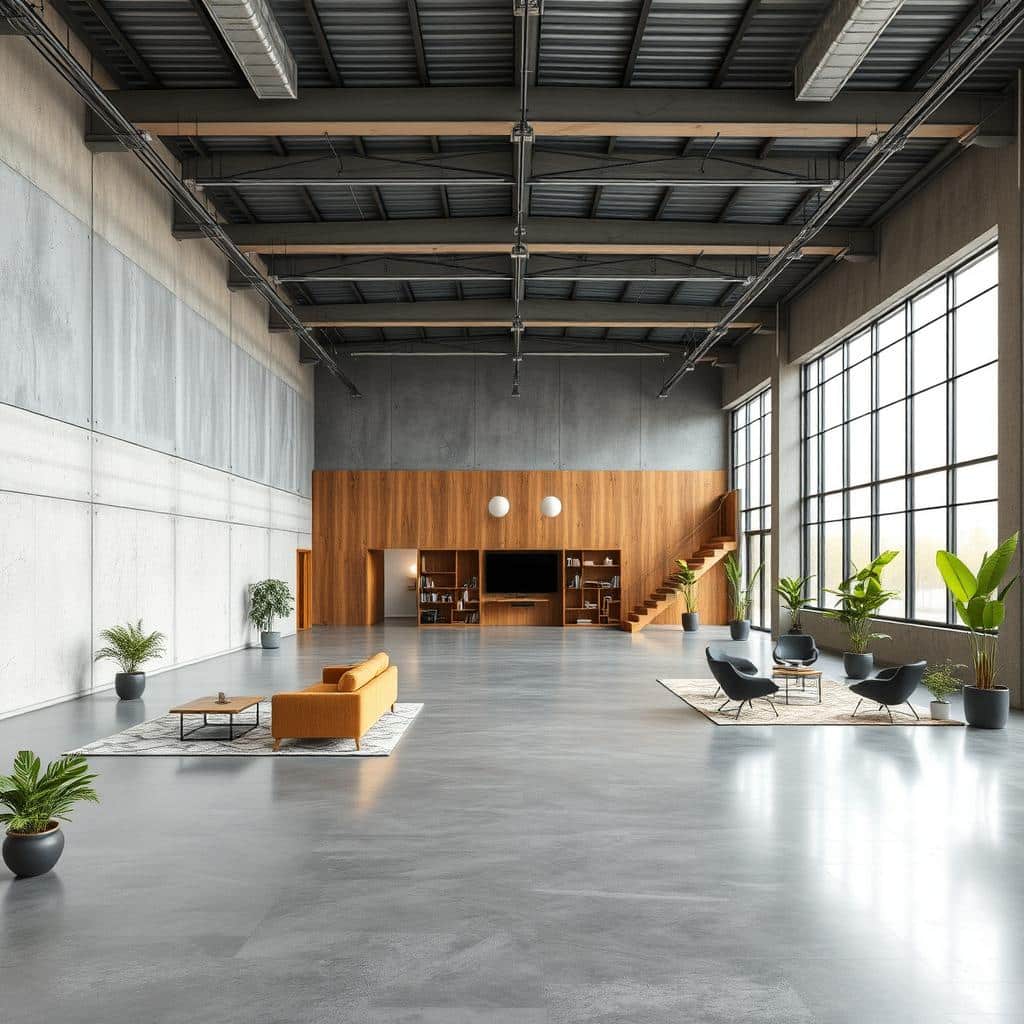
| Design Element | Percentage of Usage in Industrial Interiors |
|---|---|
| Exposed Brick Walls | 75% |
| Concrete Flooring | 85% |
| Metal Furnishings and Accents | 90% |
| Large Windows | 70% |
| Open-Concept Layout | 80% |
The table shows the common design elements in industrial interiors. These elements, like exposed brick and metal, are key to achieving the industrial look. They help create a cohesive and inviting space.
Balancing Industrial and Softness
Finding the right mix of industrial and soft design elements can make a space both beautiful and functional. A great example is to use the Marie Top sink by Silestone in White Zeus. It stands out against the industrial cement-like flooring and countertop.
To achieve this balance, it’s important to add softer touches that complement the industrial look. This can include using plush textiles like velvet or linen for throw pillows, curtains, or rugs. Adding natural elements, such as potted plants or a wood-framed mirror, can also soften the space.
Lighting is also key in finding the perfect balance. Pendant lights with soft, diffused light can make the space feel warm and welcoming. This contrasts with the more utilitarian look of industrial design.
| Industrial Elements | Soft Design Features |
|---|---|
| Exposed Brick Walls | Plush Velvet Sofa |
| Concrete Flooring | Linen Curtains |
| Metal Furniture | Wooden Accent Table |
| Pendant Lighting | Delicate Floral Arrangements |
By balancing industrial and soft design, you can create a space that’s both stunning and practical. This mix of rugged and refined elements adds depth and character. It also shows a modern and personal take on industrial style.
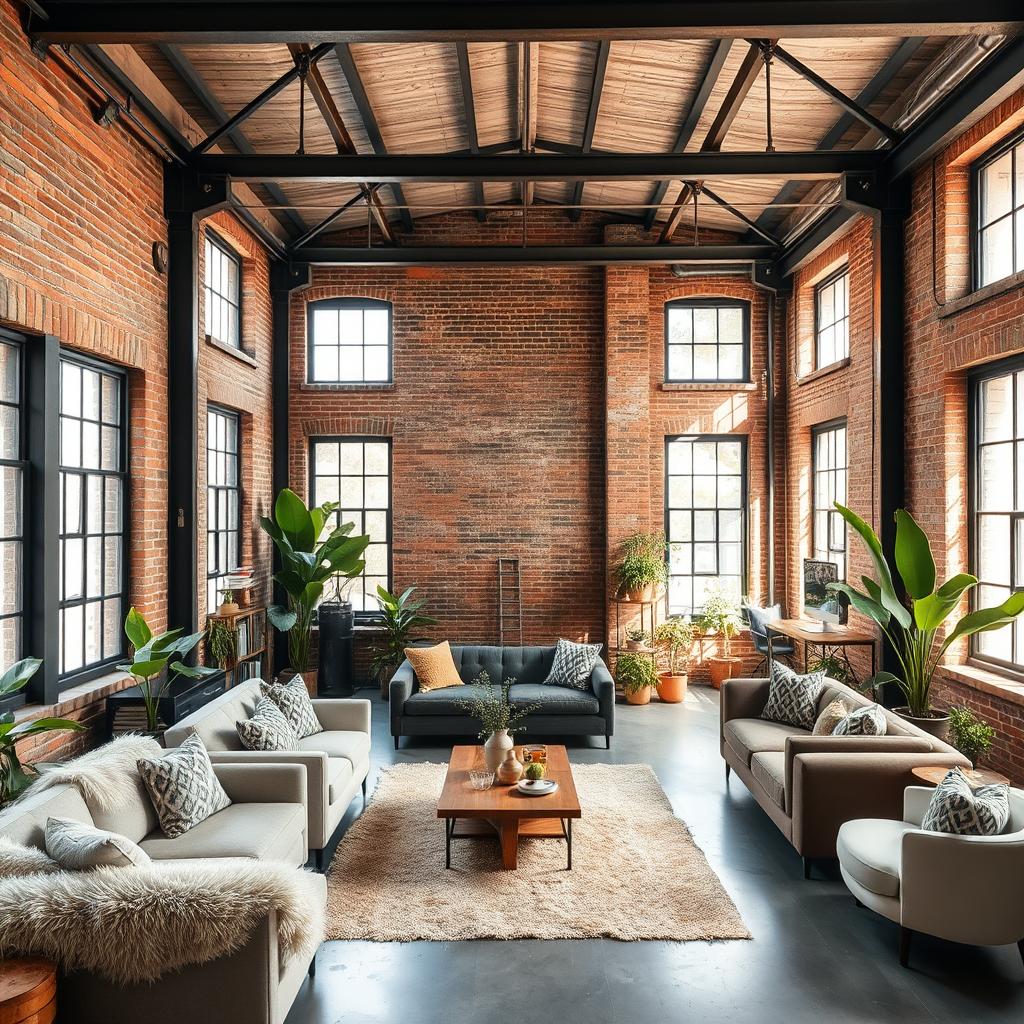
Industrial Interior Design: Modern Spaces Reimagined
Industrial spaces have been turned into offices and apartments in recent years. These spaces were once abandoned industrial areas. In the 1960s, artists in Lower Manhattan repurposed old factory spaces.
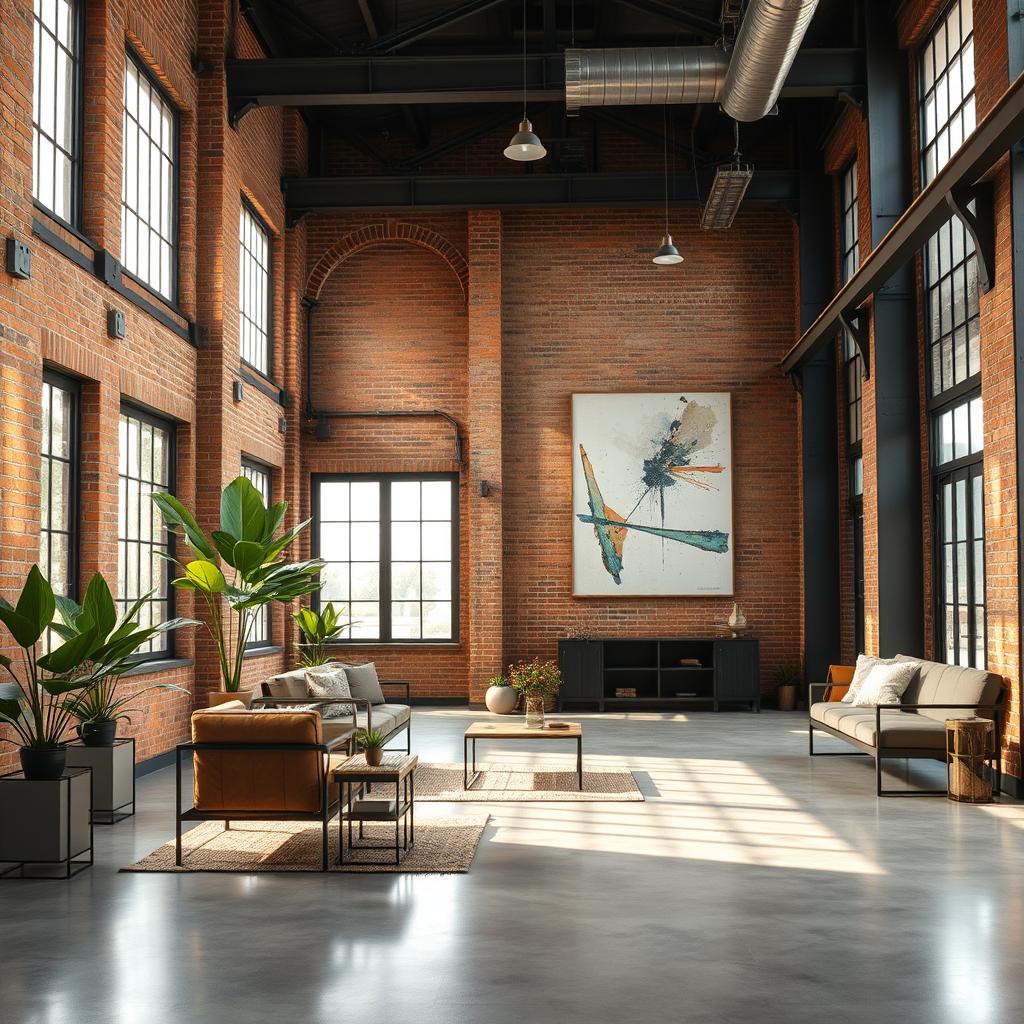
Industrial design is all about raw, unfinished looks. It uses materials like brick walls, polished concrete floors, and metal. Reclaimed materials are also popular, making the design both affordable and sustainable.
| Traditional Industrial Design | Modern Industrial Design |
|---|---|
| Leans towards classic and ornate aesthetics, warmth, and formal layouts. | Goes for a contemporary vibe, with raw materials, simplicity, and functionality. |
| Emphasizes rich materials, warm colors, and detailed designs. | Emphasizes raw materials, neutral colors, and simplicity. |
| Draws inspiration from the Industrial Revolution and mid-20th-century modernism. | Draws inspiration from the Industrial Revolution, Scandinavian design, and contemporary trends. |
Mixing traditional and modern industrial styles creates a unique look. It suits personal tastes and design goals. Industrial design offers a versatile and captivating way to transform modern spaces.
Conclusion
Industrial interior design has become a big part of modern design. It mixes raw, rugged elements with sleek, minimalist looks. Designers use this style to make spaces that are both useful and beautiful.
Exposed brick and concrete add charm, while metal and reclaimed wood bring elegance. This style lets people keep a space’s original feel while making it their own.
Industrial design is loved by many for its unique look and easy upkeep. It’s a cost-effective way to add character to any area. By using neutral colors, vintage lights, and practical furniture, designers can make spaces that are both stylish and timeless.
FAQ
What is modern industrial interior design?
Modern industrial design uses metal, beams, and reclaimed wood. It creates a unique look in cold spaces. Now, it focuses on a simple style with an industrial feel.
What are the key elements of industrial interiors?
Industrial interiors have exposed brick and beams. They use rough floors and neutral colors. Materials like leather and wood are key, along with steel and dark metal.
How can industrial design elements be incorporated into hospitality spaces?
Restaurants can use sleek black metal and exposed ducts. These features create a stylish atmosphere for guests.
What is the importance of lighting in industrial interior design?
Lighting is vital in industrial design. It adds warmth to spaces with rough finishes. Choose fixtures that fit the industrial look and provide good lighting.
How can industrial and minimalist design be combined?
Mixing industrial and minimalist design is popular. Both styles value simplicity and practicality. Minimalism in industrial design highlights clean spaces and statement pieces.
What role does practicality play in industrial interior design?
Practicality is key in industrial design, like in kitchens. Good lighting is essential for function. Choose fixtures that look industrial but work well.
How can industrial interiors embrace individual character and quirky details?
Industrial interiors can have unique touches. Add quirky art and custom lighting to make a space personal.
What are the different metal finishes used in industrial interiors?
Industrial style uses many metal finishes. Try warm coppers, subtle pewters, and bright brasses for different looks.
How can vintage-inspired industrial lighting be incorporated?
Vintage-inspired lighting adds a nostalgic touch. It blends industrial style with a hint of the past.
How can cement-like finishes and veining patterns contribute to the industrial look?
Cement-like finishes and veining patterns add to the industrial look. They create a modern yet timeless feel.
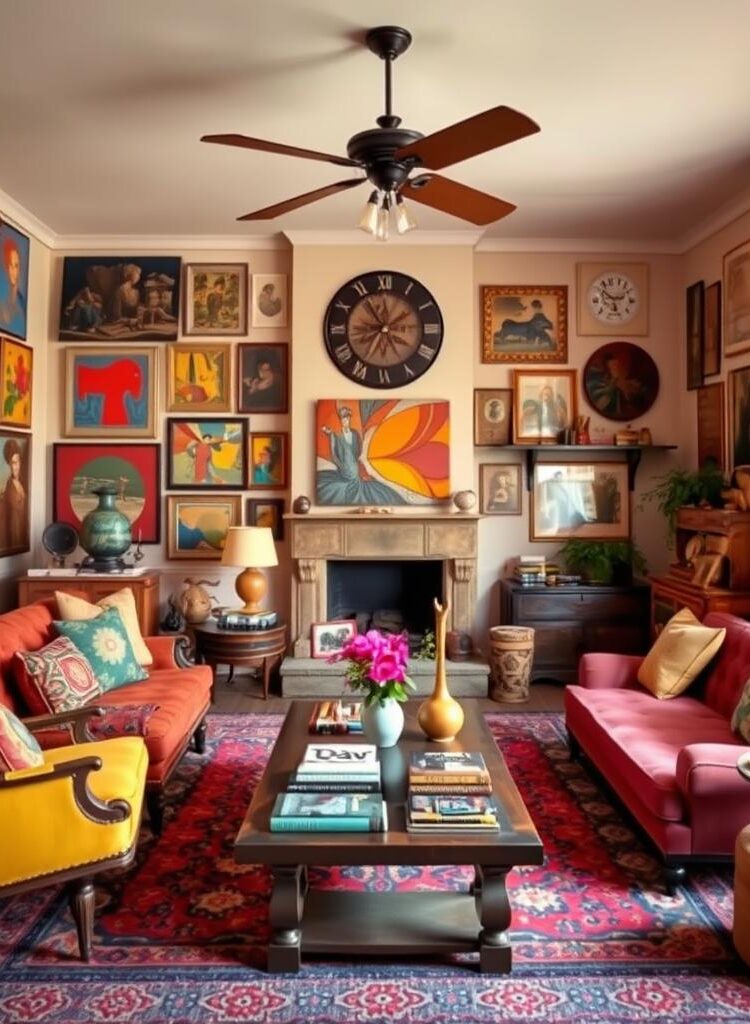
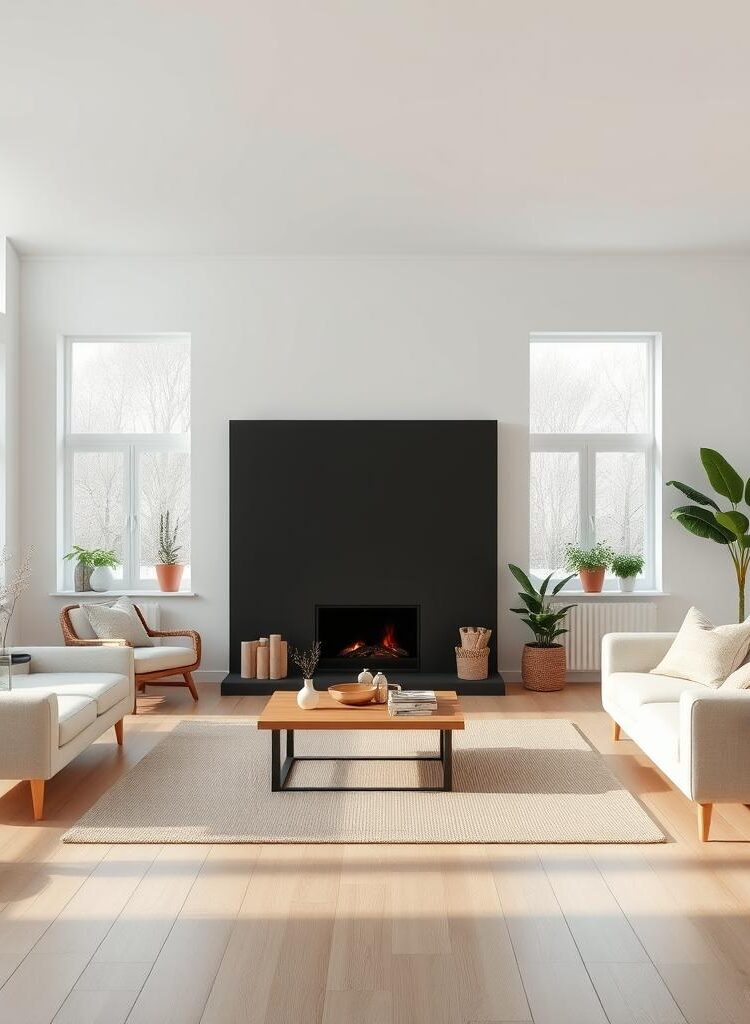
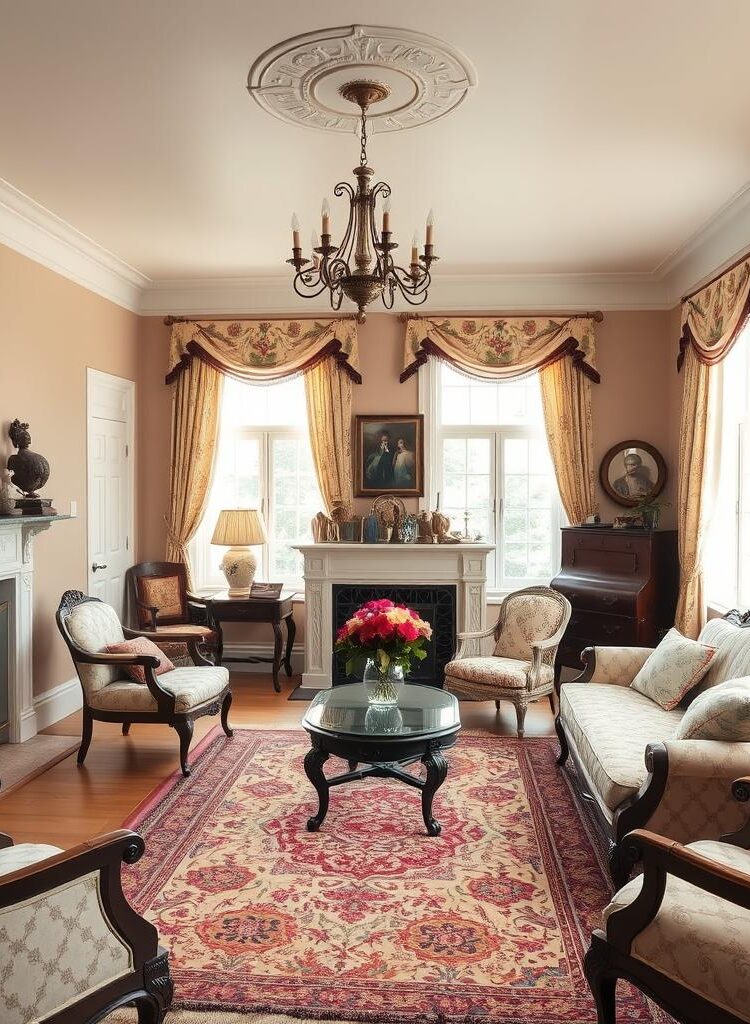
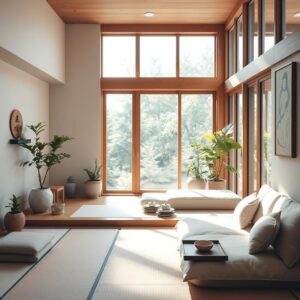
Leave a Reply